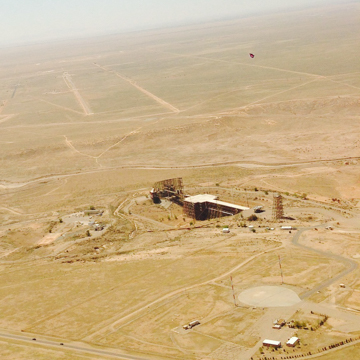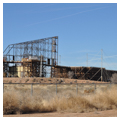You are here
ATLAS-I (Air Force Weapons Lab Transmission-Line Aircraft Simulator)
Also known as the “Trestle,” the ATLAS-I (Air Force Weapons Lab Transmission-Line Aircraft Simulator) is the largest laminated wood structure in the world. A product of the Cold War, nuclear technology, and military engineering, it was created in response to the accelerating nuclear arms race and was intended to demonstrate U.S. invulnerability to attack by the Soviet Union.
The Trestle is located on Kirtland Air Force Base in Albuquerque, in close proximity to the Manzano Base nuclear stockpile, and to the nuclear weapons research, development, and testing facilities of Sandia National Laboratories, the Air Force Special Weapons Command, and Los Alamos National Laboratory. It is an electromagnetic pulse generator designed and constructed by the Air Force Weapons Laboratory to simulate and test the effects of exoatmospheric, or high-altitude, nuclear detonations on military electronics, aircraft, telecommunications systems, and satellites.
Kirtland Air Force Base and the related nuclear facilities originated with the Manhattan Project, the initiative of the United States to build an atomic bomb during World War II. Between 1942 and 1944, as scientists at Los Alamos Laboratory (Site Y of the Manhattan Project) were designing the atomic bombs dropped on Hiroshima and Nagasaki, the National Defense Research Committee secured 30,000 acres of land on the East Mesa and established the New Mexico Proving Ground site to conduct proximity fuze testing. In 1945, Sandia Laboratory (then known as “Z Division” and now part of Sandia National Laboratories) was created to oversee further nuclear weapons component development and testing at Kirtland Field. Today, Kirtland is the primary Air Force facility responsible for the testing and functional integration of weapons designed at Los Alamos National Laboratory and Sandia National Laboratories—two of the nation’s three National Nuclear Security Administration Laboratories, both of which maintain major facilities in New Mexico to the present day.
The idea for the Trestle originated with John Malik, a Los Alamos scientist. Working under the direction of Carl Baum of the Air Force Research Laboratory, teams of architectural, civil, and nuclear engineers designed the Atlas-I in the late 1960s and early 1970s. The contractors, McDonald-Douglas Aircraft Company, R.D. Krause Engineering, and W.C. Kruger and Associates, erected the structure at Kirtland Air Force Base between 1972 and 1980, at a cost of over $60 million.
Atlas-I consists of three main components. First, a 12-story-high “Trestle” platform, which is sunk inside the bowl of the 120-foot-deep Tijeras Arroyo, with a 1,300-foot-long deck at ground level that could support the weight of a 100-ton B-52 bomber. Second, a pulse source composed of two Marx generators, or steel wave-focusing towers, from which electromagnetic pulse waves were generated and shot at a plane positioned on the deck. And third, a 127-foot-tall pulse terminator support tower containing an energy-absorbing electromechanical dispersion device. Collectively, these components span nearly a quarter mile and occupy a site of over 20 acres.
From the time of its completion in 1980 until 1991, ATLAS-I was used to conduct classified experiments to determine the effects of electromagnetic waves on electronics in military aircraft. For this reason, the Trestle platform was constructed with almost no metal parts. The structure of interlocking trusses was built from 6.5 million board feet of 12 x 12–inch, glue-laminated wooden members made from southern pine and Douglas fir lumber, with the 10,000 structural joints held together by 60,000 wood and fiberglass bolts. This produced a dielectric structure that is capable of supporting 275 tons of weight while sustaining wind loads of 40 miles per hour, but is undetectable by aircraft electronics and virtually invisible to the radiation waves emitted by a MARX generator. In effect, the “Trestle” allowed experimenters to simulate the conditions of an aircraft in flight.
The Atlas-I is no longer operational; despite preservation efforts, it has not been nominated to the National Register of Historic Places. The structure is closed to the public, but is visible from the air and can be viewed from the surrounding non-restricted area by contacting the Kirtland Public Affairs Office.
References
Malik, John. “The Yields of the Hiroshima and Nagasaki Nuclear Explosions.” Los Alamos, NM: Los Alamos Scientific Laboratory, 1985. Accessed May 2, 2014. http://www.fas.org/sgp/othergov/doe/lanl/docs1/00313791.pdf.
Partridge, Ralph E. “Note 1: EMP Testing Facility (25 February 1964).” Los Alamos, CA: Los Alamos Scientific Laboratory, 1964. Accessed May 2, 2014. http://www.ece.unm.edu/summa/notes/SSN/note1.pdf
Reuben, Charles. “Empire My Prince: Carl Baum, Trestle Maker.” Alibi, January 6-12, 2011.
Reuben, Charles. “The Atlas-I Trestle at Kirtland Air Force Base.” Albuquerque: University of New Mexico Electrical and Computer Engineering Department, 2012. Accessed May 2, 2014. http://www.ece.unm.edu/summa/notes/trestle.html.
Schaefer, Richard R. “Nuclear Criteria and System Design Specification.” Santa Monica, CA: The Rand Corporation, 1970.
Van Citters, Karen and Deborah Butcher. Documentation of the Trestle at Kirtland Air Force Base, New Mexico. KAFB Working Paper 11-03, Van Citters Historic Preservation, LLC for Kirtland Air Force Base, Albuquerque, NM, 2003.
Van Citters, Karen and Kristen Bisson. Kirtland Air Force Base, Albuquerque, New Mexico, National Register of Historic Places Historic Context and Evaluation. KAFB Working Paper 06-03, 377th Civil Engineering Squadron, Environmental Flight Quality Section, Van Citters Historic Preservation, LLC for Kirtland Air Force Base, Albuquerque, NM, 2003. http://www.denix.osd.mil/cr/upload/kirtland-historic-context_0.pdf.
Writing Credits
If SAH Archipedia has been useful to you, please consider supporting it.
SAH Archipedia tells the story of the United States through its buildings, landscapes, and cities. This freely available resource empowers the public with authoritative knowledge that deepens their understanding and appreciation of the built environment. But the Society of Architectural Historians, which created SAH Archipedia with University of Virginia Press, needs your support to maintain the high-caliber research, writing, photography, cartography, editing, design, and programming that make SAH Archipedia a trusted online resource available to all who value the history of place, heritage tourism, and learning.















